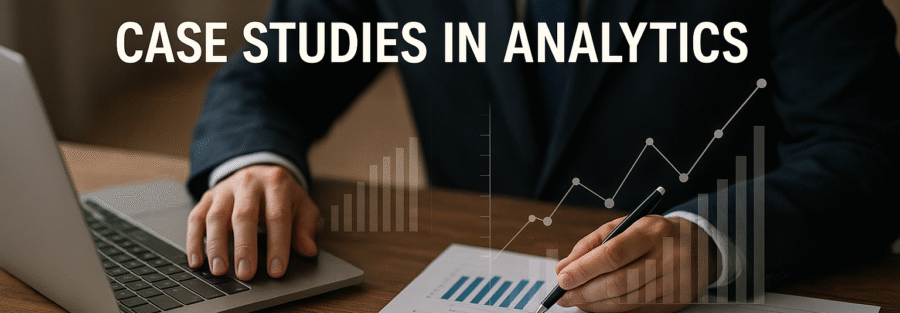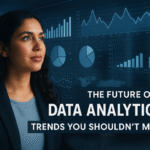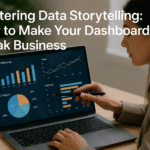In a world where data is considered the new oil, it’s no surprise that some of the most successful businesses on the planet are thriving because of their data-driven strategies. From improving customer experiences to optimizing supply chains, data analytics is powering smarter decisions and driving tangible results. But how are leading brands actually using data in practice? What lessons can we learn from the giants of industry? This is the essence of Data-Driven Success: Case Studies in Analytics.
Welcome to a deep dive into real-world case studies that show exactly how data analytics has become the backbone of business success. From Amazon and Netflix to Starbucks and Uber, these companies aren’t just using data — they’re mastering it. Let’s break down what they’re doing, how they’re doing it, and what your business can take away from their strategies in the context of Data-Driven Success: Case Studies in Analytics.
Introduction to Data-Driven Success
Why Case Studies Matter in Analytics
When we talk about data analytics, it’s easy to get lost in technical jargon and abstract theory. That’s where case studies come in. They put the theory into context and show you how analytics actually works in the real world.
Case studies highlight real challenges and real wins. They demonstrate how businesses are making decisions faster, personalizing at scale, predicting trends before they happen, and outperforming the competition — all thanks to data. For leaders and teams looking to implement analytics, these success stories can offer a blueprint or spark ideas.
The Rise of Data as a Competitive Advantage
We’re no longer in the age where data is optional. In fact, data-driven companies are 19 times more likely to be profitable, according to industry reports. That’s not just a stat — it’s a call to action.
The organizations you’ll read about in this article all have one thing in common: they treat data as a strategic asset. They collect it relentlessly, process it efficiently, and — most importantly — act on it decisively.
Case Study 1 – Amazon’s Data Mastery
Customer Personalization with Machine Learning
Amazon isn’t just an e-commerce company; it’s a data company disguised as one. One of the most well-known examples of data success is how Amazon uses machine learning to deliver hyper-personalized recommendations. You’ve probably noticed how accurate those “customers who bought this also bought…” suggestions are — that’s not magic. It’s deep analytics at work.
Amazon’s recommendation engine reportedly generates 35% of its revenue, according to McKinsey. They analyze everything — browsing habits, time spent on product pages, previous purchases, cart activity, and even your interactions with customer service — to build a behavioral profile.
This system doesn’t just benefit Amazon. Customers get a smoother, more relevant shopping experience. That’s the win-win of personalization powered by data.
Inventory and Logistics Optimization
Amazon also uses predictive analytics to manage one of the most complex supply chains in the world. Their anticipatory shipping model forecasts demand so well that they can ship items to regional distribution centers before customers even place orders.
This minimizes delivery time, lowers shipping costs, and improves customer satisfaction — all thanks to their ability to predict what, when, and where people will buy.
Case Study 2 – Netflix: Predicting Preferences
How Netflix Uses Viewing Data
Netflix has over 230 million subscribers, and each one of them gets a unique viewing experience. How? Through an intricate web of data collection and analysis.
Every time you pause, rewind, binge-watch, or abandon a show after 10 minutes, Netflix is taking notes. They track data points like:
- What time you watch
- What device you use
- How long you watch a title
- Which thumbnails make you click
They use this information to personalize your homepage, offer suggestions, and even change thumbnail images based on your preferences. This keeps users engaged and subscribed.
Content Creation Based on Analytics
Ever wonder how Netflix decides what content to invest in? It’s not just creative hunches — it’s data. The iconic series “House of Cards” was developed after Netflix analyzed viewing data and found:
- A large audience interested in political thrillers
- A fan base for Kevin Spacey and David Fincher
- Strong performance of similar titles
By greenlighting shows based on viewer preferences, Netflix minimizes risk and maximizes viewership. It’s a perfect example of data-informed content production.
Case Study 3 – Starbucks’ Strategic Decisions
Site Selection Through Geographic Data
Starbucks isn’t just opening stores on every corner randomly. They use geospatial analytics to decide where to place new locations. By analyzing factors like traffic patterns, population density, local income levels, and proximity to competitors, Starbucks ensures that each new shop is strategically placed for maximum profitability.
This model allows them to avoid cannibalizing existing stores while capturing untapped markets.
Personalized Offers with Loyalty App Insights
Starbucks also uses data from its mobile app to deliver personalized offers and promotions. The app tracks what you order, when you order it, and where you are. Then it uses machine learning to predict when you’re likely to want a coffee — and sends you a push notification just in time.
This real-time personalization drives higher sales and deepens customer loyalty. The more you use the app, the better it understands you — and the more likely you are to keep coming back.
Case Study 4 – Walmart’s Supply Chain Analytics
Inventory Forecasting with Big Data
Walmart operates on razor-thin margins, so efficiency is everything. They use big data analytics to monitor sales patterns across thousands of stores and predict future demand. This allows them to stock just enough of each product — not too much, not too little.
Their system can detect spikes in product demand due to weather patterns, holidays, or even social media trends, ensuring shelves are stocked before customers even realize they need something.
Real-Time Analytics in Store Operations
Walmart’s in-store data feeds into central dashboards that help managers monitor real-time performance. From checkout speed to shelf restocking, every action is data-driven. This leads to better labor scheduling, fewer stockouts, and happier shoppers.
Case Study 5 – Uber and Dynamic Pricing
Real-Time Demand and Pricing Adjustments
Ever noticed that an Uber ride costs more during rush hour or bad weather? That’s not arbitrary — it’s powered by real-time dynamic pricing algorithms. Uber collects enormous volumes of data every second, including:
- Number of ride requests in an area
- Number of available drivers
- Current traffic conditions
- Special events (concerts, games, etc.)
- Historical demand patterns
This data feeds into their surge pricing system, which automatically adjusts rates to balance supply and demand. It’s a win-win: drivers earn more, and riders who really need a lift can still find one.
The impressive part? All of this happens in real time. The pricing algorithm recalibrates by the second, offering seamless service without manual intervention.
Route Optimization with Predictive Models
Uber’s use of data doesn’t stop at pricing. Their route optimization system analyzes traffic data, road closures, weather, and driver behavior to suggest the fastest, safest, and most fuel-efficient routes.
This not only improves the customer experience but also lowers operational costs. And when scaled across millions of daily rides, the impact is massive. It’s data science on the move — literally.
Case Study 6 – Spotify and User Engagement
Music Recommendations with Deep Analytics
Spotify is more than a music app — it’s an algorithm powerhouse. With over 600 million users, the platform gathers listening data to create highly personalized playlists like “Discover Weekly” and “Release Radar.”
Spotify uses a blend of collaborative filtering, natural language processing, and audio analysis to predict what songs you’ll love next. It analyzes:
- Listening frequency and duration
- Song skips and replays
- Playlist saves
- Time of day usage
- Social sharing behaviors
The result? Listeners are constantly discovering music tailored to their unique tastes, keeping them on the app longer — and increasing Spotify’s ad and subscription revenue.
Audience Segmentation and Advertising Strategy
Spotify’s data also powers its ad-targeting engine. Brands can target ads based on user behaviors like:
- Workout listeners
- Commuters
- Podcast fans
- Genre-lovers
These hyper-segmented audiences give advertisers better ROI and help Spotify generate billions from its free-tier users. Again, it’s all thanks to precise, real-time analytics.
Lessons Learned from Leading Data-Driven Brands
Data Alone Isn’t Enough — Strategy Matters
One of the most important takeaways from these case studies is this: having data is not the same as using it effectively. Many businesses collect data — but few actually act on it.
Top performers like Amazon, Netflix, and Uber succeed because they have a clear strategy. They align data initiatives with business goals, measure what matters, and iterate constantly. Data is not just a back-office function — it’s a strategic engine.
Scaling Analytics Across the Organization
Another lesson is the power of scalability. These companies don’t limit analytics to one department. Marketing, sales, logistics, HR — every team has access to insights and the tools to act on them.
This creates a culture of continuous improvement where everyone from executives to frontline workers is empowered to make smarter decisions.
Challenges Faced in Data-Driven Transformations
Data Silos and Integration Issues
Even the best companies struggle with data silos — when different departments store their data separately, making it hard to see the full picture.
For example, marketing might use one CRM, customer support another, and sales yet another. Integrating these systems is often a major technical hurdle. Without integration, data loses its context and power.
This is why many organizations invest in data lakes or cloud platforms that centralize and standardize data across teams.
Resistance to Change and Data Literacy Gaps
Technology isn’t the only challenge — people are too. Many employees are hesitant to trust analytics or adopt new tools. If teams aren’t trained to interpret dashboards or don’t understand how data can help them, your efforts will stall.
That’s why change management and data literacy training are essential. Everyone in the organization needs to feel confident using data in their daily work.
Building a Data-Driven Culture
Leadership Commitment and Change Management
For a data strategy to succeed, leadership must lead by example. That means using data to make decisions, setting performance metrics, and holding teams accountable.
Leaders also need to communicate the “why” behind data initiatives. When people understand how data will help them work smarter — not harder — they’re far more likely to adopt it.
Moreover, leadership must fund and support analytics projects even when ROI isn’t immediate. Building an analytics infrastructure is an investment that pays off over time.
Empowering Teams with Tools and Training
Empowering teams means giving them access to the right tools — and the training to use them. Tools like Tableau, Power BI, Google Looker, and others democratize analytics by making dashboards user-friendly and interactive.
But without proper training, these tools are just expensive toys. Organizations must invest in upskilling their workforce so that every team member can extract insights, not just the data scientists.
Ultimately, a true data-driven culture exists when analytics becomes second nature — part of daily decisions, big and small.
Future Outlook: The Next Phase of Data-Driven Innovation
Predictive and Prescriptive Dominance
Looking ahead, businesses are moving beyond just understanding what has happened to predicting what will happen — and even prescribing what should happen next. This is where predictive and prescriptive analytics take center stage.
Predictive analytics uses machine learning and statistical models to forecast outcomes. For example:
- Retailers predict customer churn before it happens.
- Banks assess loan default risk.
- HR teams predict employee attrition.
Prescriptive analytics takes it a step further by recommending the best actions to take. For instance, an e-commerce system might suggest offering a discount to a customer who’s likely to abandon their cart — before they even do.
This is the cutting edge of analytics, and it’s rapidly becoming more accessible to businesses of all sizes.
The Role of AI and Automation in Scaling Insights
Artificial intelligence is turbocharging the analytics game. AI systems can now process billions of data points in seconds, identify patterns humans would miss, and even generate real-time insights without any manual effort.
More exciting still is automated decision-making. We’re entering a future where AI systems don’t just suggest actions — they execute them autonomously. Think of smart inventory systems that reorder stock automatically or marketing platforms that adjust bids and budgets in real-time.
As AI becomes more integrated into analytics tools, the speed, scale, and sophistication of insights will redefine what’s possible for businesses. The companies that embrace this future now will be the industry leaders tomorrow.
Getting Started: How Businesses Can Begin Their Analytics Journey
Laying the Foundation with Clean Data
The first step in any analytics journey is data hygiene. You can’t expect accurate insights from dirty data. That means:
- Removing duplicates and errors
- Standardizing formats
- Ensuring up-to-date information
- Securing sensitive data properly
Businesses need to implement data governance frameworks — rules and processes that ensure the integrity, security, and accessibility of data.
Once your data is clean and centralized, the real magic begins.
Choosing Tools and Building the Right Team
There’s no shortage of analytics tools, but the key is choosing what fits your business size, industry, and goals. Here’s a quick breakdown:
| Tool | Best For | Notable Features |
|---|---|---|
| Google Analytics | Website and traffic analysis | Free, customizable dashboards |
| Tableau | Data visualization | Drag-and-drop interface |
| Power BI | Business intelligence | Seamless Microsoft integration |
| Looker | Cloud analytics (Google Cloud) | Strong SQL modeling layer |
| SAS | Advanced analytics | Statistical modeling and forecasting |
As for talent, you’ll need a blend of:
- Data engineers (to manage infrastructure)
- Data analysts (to interpret data)
- Data scientists (to model and predict)
- Business stakeholders (to define use cases)
Start small, solve specific problems, and scale gradually. You don’t need to boil the ocean — just find your biggest pain point and let data guide the solution.
Conclusion
Data is no longer the future — it’s the now. Across industries and continents, businesses that lean into data-driven strategies are pulling ahead. Whether it’s Amazon predicting what you’ll buy next, Uber pricing rides dynamically, or Spotify recommending your next favorite song, the power of analytics is clear.
These case studies aren’t just impressive success stories — they’re playbooks. They show how to use data to drive personalization, optimize operations, reduce costs, and deliver better experiences. But most importantly, they prove that any business can do it — with the right strategy, tools, and culture.
If you’re not using data, you’re leaving money — and opportunity — on the table. Start small, build momentum, and commit to the long game. Because in a world where every click, swipe, and sale creates data, those who analyze will lead. And those who don’t will fall behind.
FAQs
How do real businesses use data analytics successfully?
Real businesses use data analytics to improve decision-making, optimize operations, personalize customer experiences, forecast demand, reduce risk, and gain a competitive edge. Case studies like Amazon, Netflix, and Uber show how deep analytics translates into real-world impact.
What makes a good data analytics strategy?
A good strategy aligns analytics goals with business objectives. It focuses on high-impact use cases, ensures clean and centralized data, uses the right tools, builds the right team, and creates a culture where insights drive actions.
Can small businesses also apply these analytics strategies?
Absolutely. Many analytics tools are affordable and scalable. Even simple dashboards and basic customer insights can give small businesses a big edge. The key is starting with a specific problem or goal and building from there.
What is the ROI of using data analytics?
While ROI varies, companies that invest in analytics report improved efficiency, better decision-making, increased revenue, and lower operational costs. McKinsey reports that data-driven companies are significantly more profitable and innovative.
What are common challenges in implementing analytics?
The biggest challenges include poor data quality, data silos, lack of skilled personnel, and resistance to change. Solving these requires strong leadership, effective training, and investing in scalable infrastructure.



